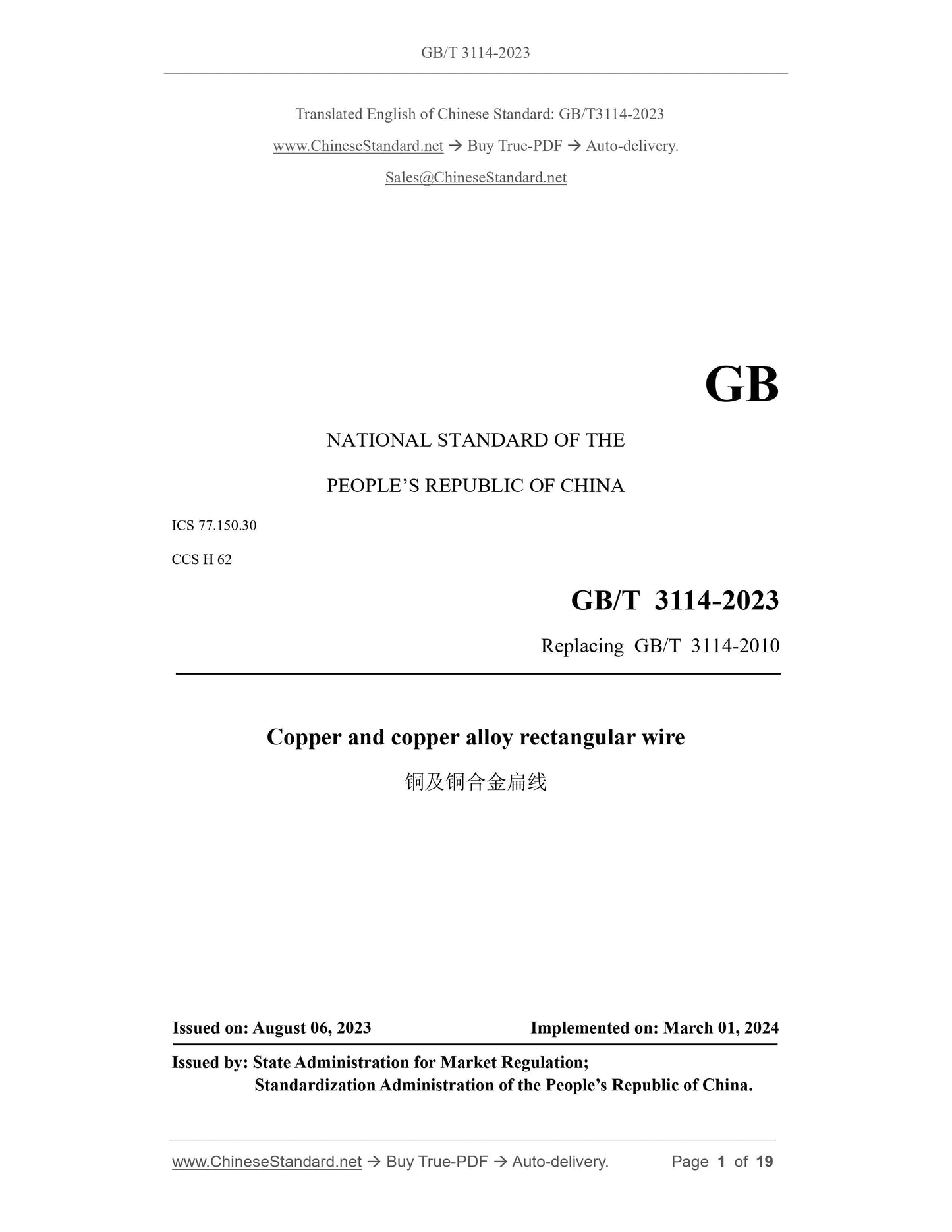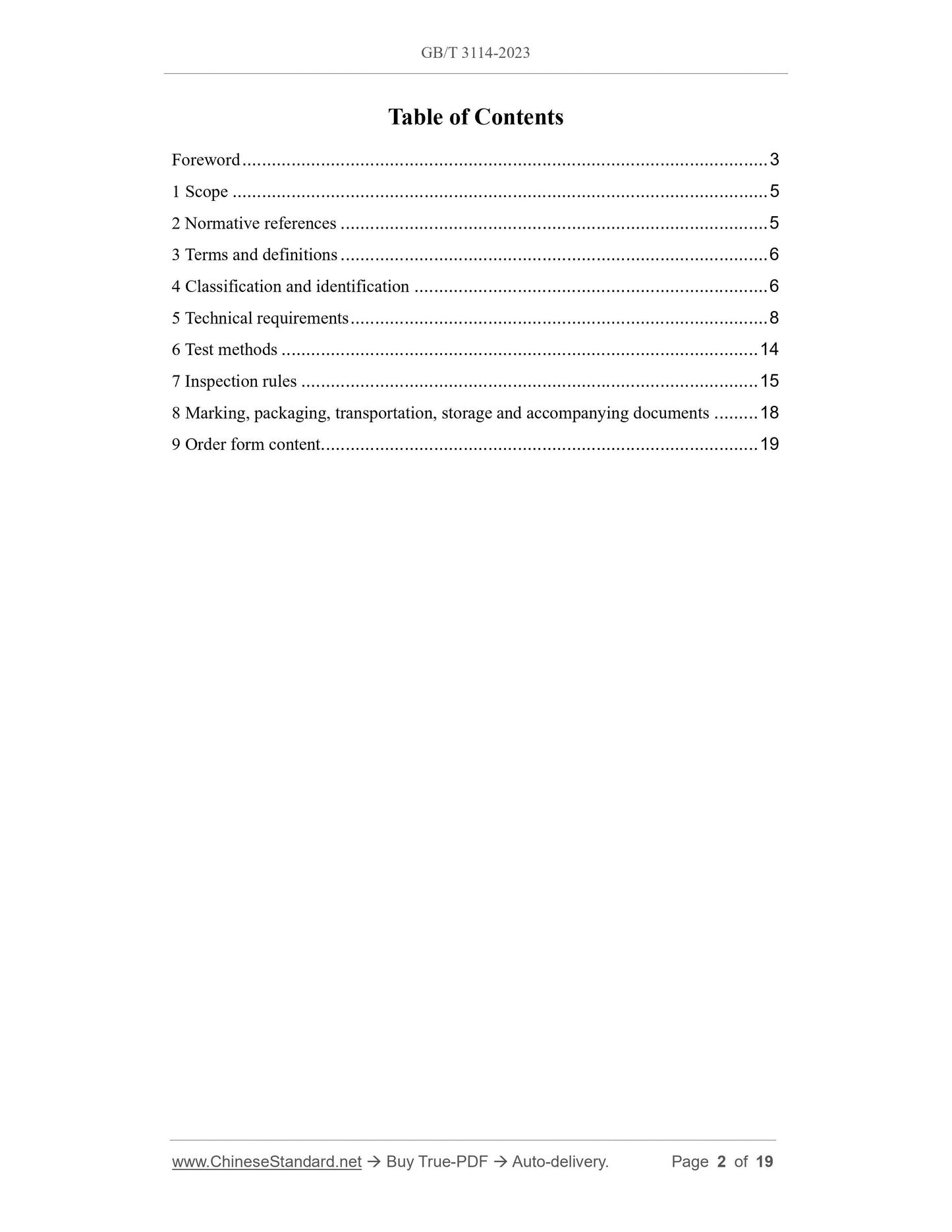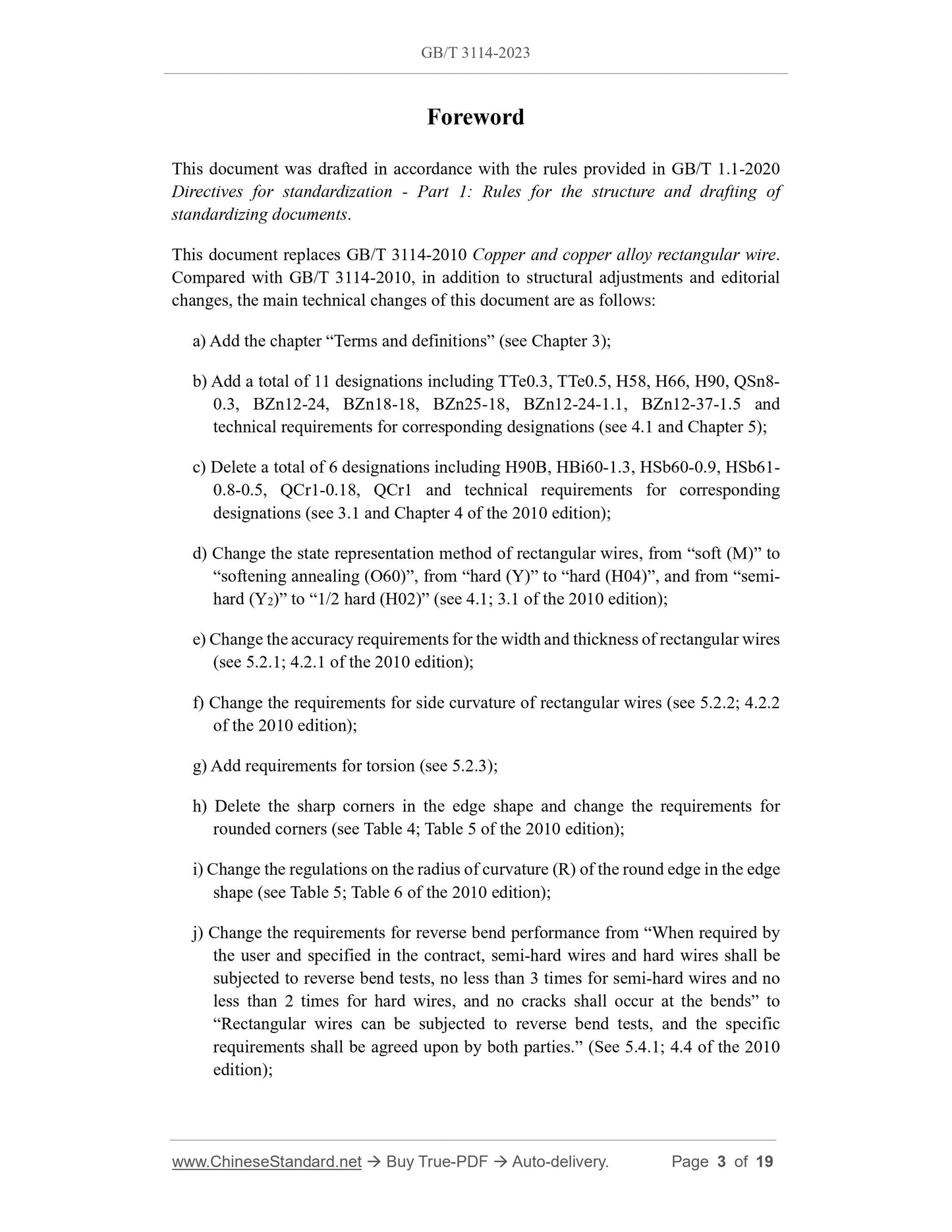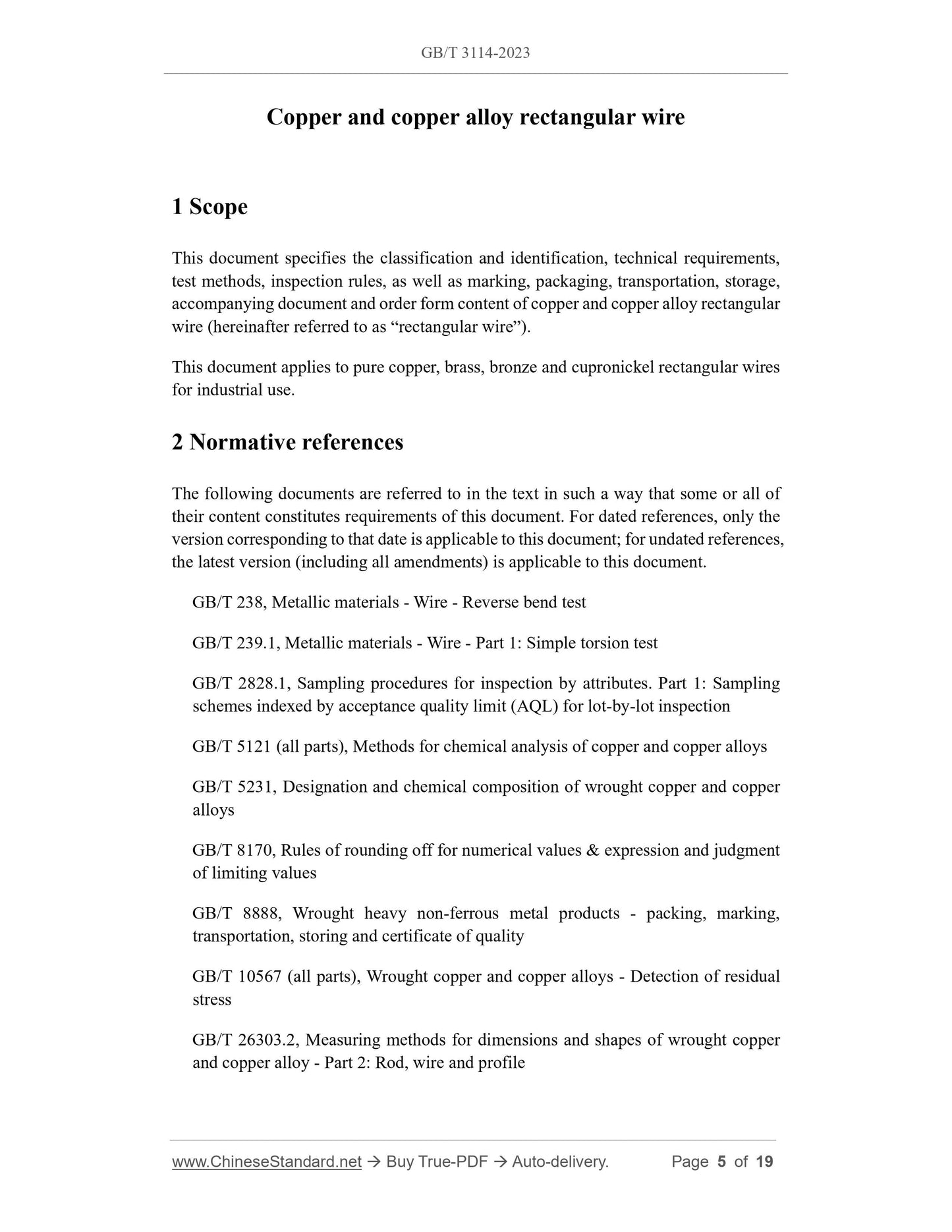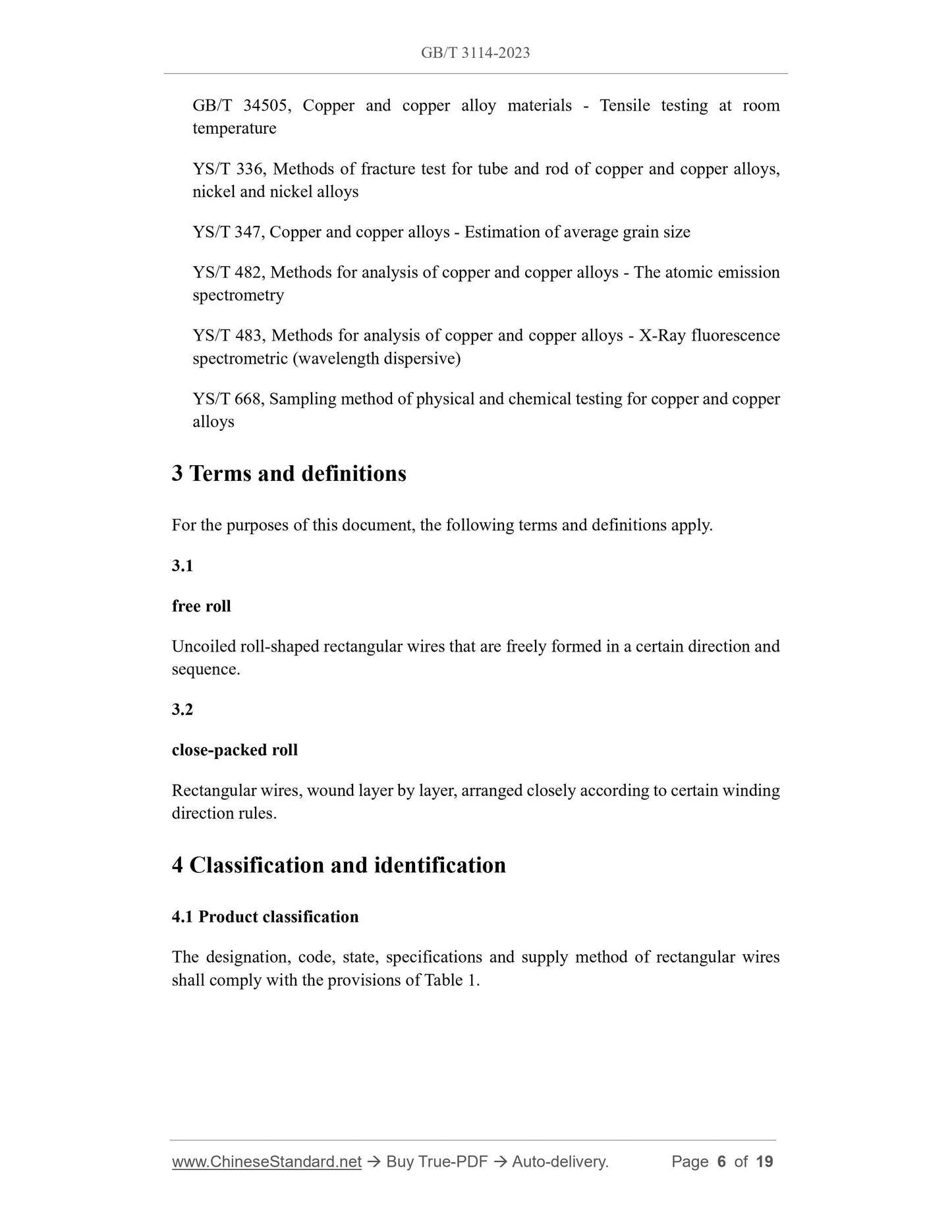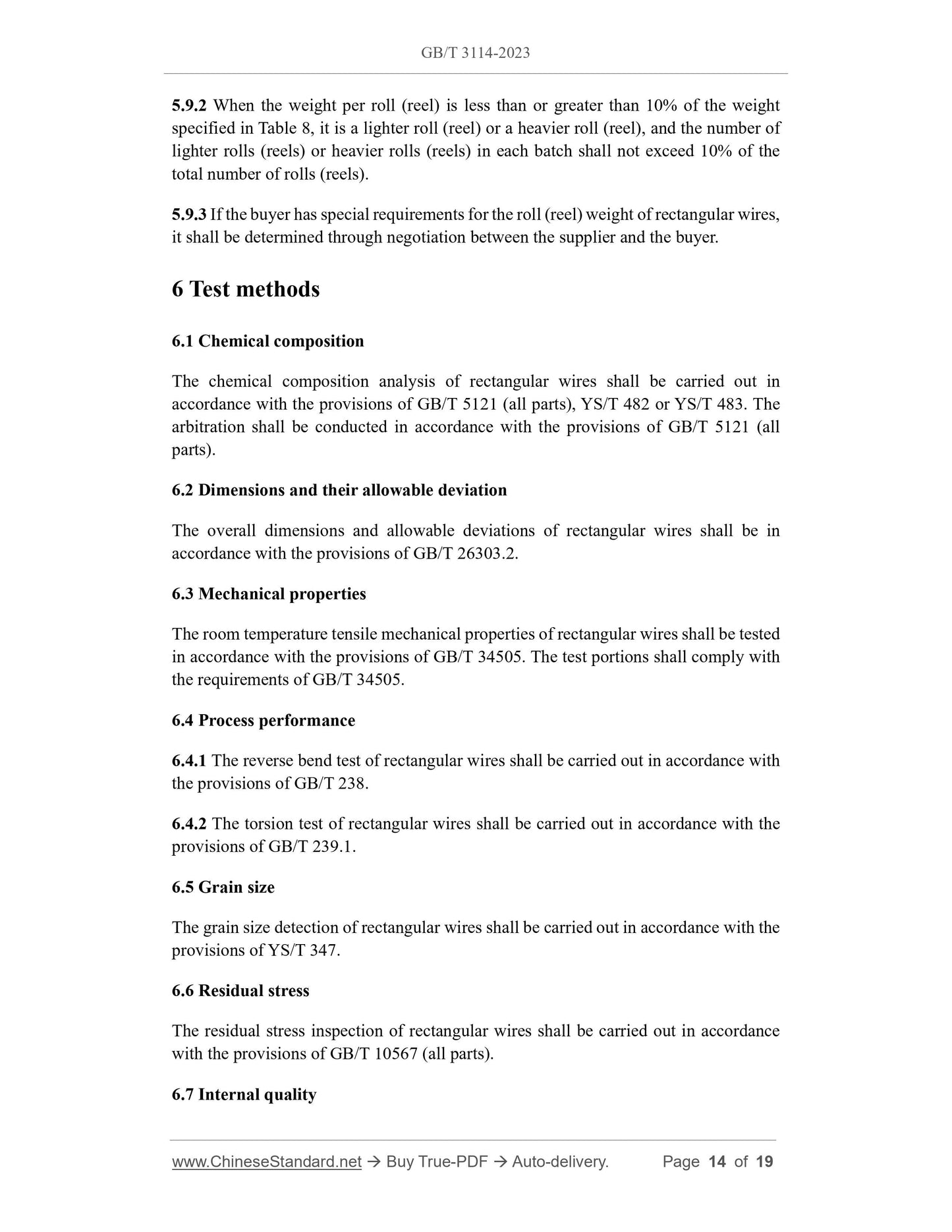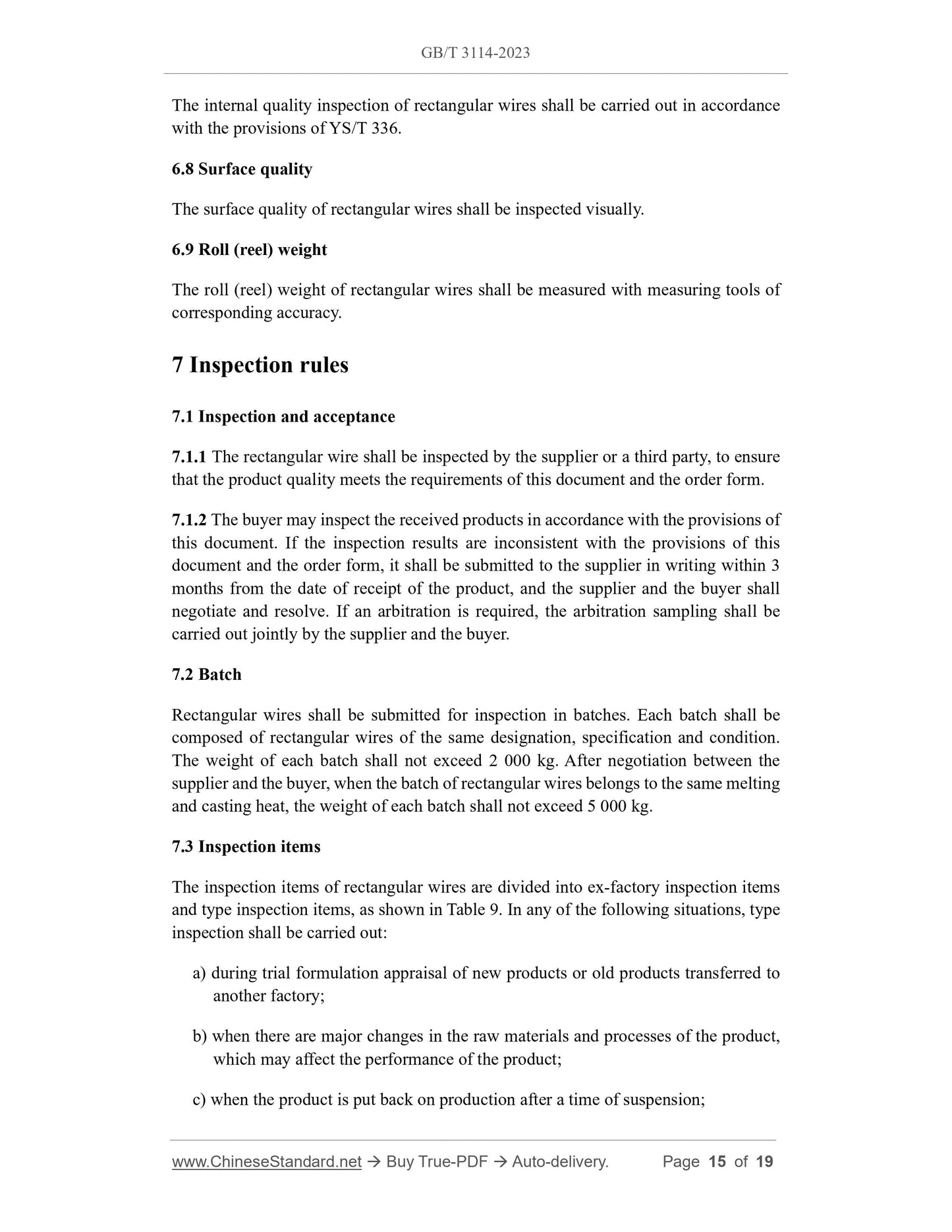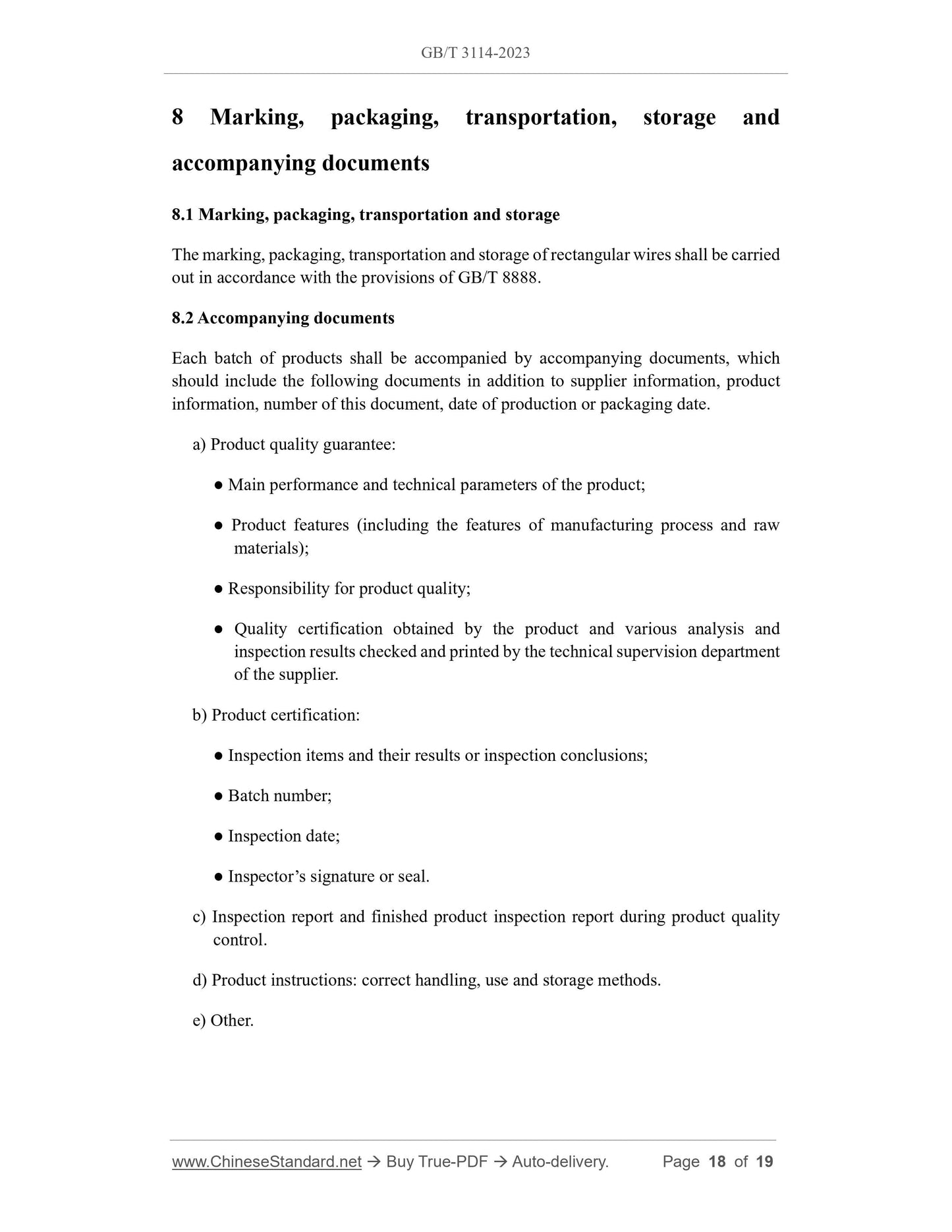1
/
of
8
PayPal, credit cards. Download editable-PDF and invoice in 1 second!
GB/T 3114-2023 English PDF (GBT3114-2023)
GB/T 3114-2023 English PDF (GBT3114-2023)
Regular price
$260.00 USD
Regular price
Sale price
$260.00 USD
Unit price
/
per
Shipping calculated at checkout.
Couldn't load pickup availability
Delivery: 3 seconds. Download true-PDF + Invoice.
Get QUOTATION in 1-minute: Click GB/T 3114-2023
Historical versions: GB/T 3114-2023
Preview True-PDF (Reload/Scroll if blank)
GB/T 3114-2023: Copper and copper alloy rectangular wire
GB/T 3114-2023
GB
NATIONAL STANDARD OF THE
PEOPLE’S REPUBLIC OF CHINA
ICS 77.150.30
CCS H 62
Replacing GB/T 3114-2010
Copper and copper alloy rectangular wire
ISSUED ON: AUGUST 06, 2023
IMPLEMENTED ON: MARCH 01, 2024
Issued by: State Administration for Market Regulation;
Standardization Administration of the People’s Republic of China.
Table of Contents
Foreword ... 3
1 Scope ... 5
2 Normative references ... 5
3 Terms and definitions ... 6
4 Classification and identification ... 6
5 Technical requirements ... 8
6 Test methods ... 14
7 Inspection rules ... 15
8 Marking, packaging, transportation, storage and accompanying documents ... 18
9 Order form content... 19
Foreword
This document was drafted in accordance with the rules provided in GB/T 1.1-2020
Directives for standardization - Part 1: Rules for the structure and drafting of
standardizing documents.
This document replaces GB/T 3114-2010 Copper and copper alloy rectangular wire.
Compared with GB/T 3114-2010, in addition to structural adjustments and editorial
changes, the main technical changes of this document are as follows:
a) Add the chapter “Terms and definitions” (see Chapter 3);
b) Add a total of 11 designations including TTe0.3, TTe0.5, H58, H66, H90, QSn8-
0.3, BZn12-24, BZn18-18, BZn25-18, BZn12-24-1.1, BZn12-37-1.5 and
technical requirements for corresponding designations (see 4.1 and Chapter 5);
c) Delete a total of 6 designations including H90B, HBi60-1.3, HSb60-0.9, HSb61-
0.8-0.5, QCr1-0.18, QCr1 and technical requirements for corresponding
designations (see 3.1 and Chapter 4 of the 2010 edition);
d) Change the state representation method of rectangular wires, from “soft (M)” to
“softening annealing (O60)”, from “hard (Y)” to “hard (H04)”, and from “semi-
hard (Y2)” to “1/2 hard (H02)” (see 4.1; 3.1 of the 2010 edition);
e) Change the accuracy requirements for the width and thickness of rectangular wires
(see 5.2.1; 4.2.1 of the 2010 edition);
f) Change the requirements for side curvature of rectangular wires (see 5.2.2; 4.2.2
of the 2010 edition);
g) Add requirements for torsion (see 5.2.3);
h) Delete the sharp corners in the edge shape and change the requirements for
rounded corners (see Table 4; Table 5 of the 2010 edition);
i) Change the regulations on the radius of curvature (R) of the round edge in the edge
shape (see Table 5; Table 6 of the 2010 edition);
j) Change the requirements for reverse bend performance from “When required by
the user and specified in the contract, semi-hard wires and hard wires shall be
subjected to reverse bend tests, no less than 3 times for semi-hard wires and no
less than 2 times for hard wires, and no cracks shall occur at the bends” to
“Rectangular wires can be subjected to reverse bend tests, and the specific
requirements shall be agreed upon by both parties.” (See 5.4.1; 4.4 of the 2010
edition);
Copper and copper alloy rectangular wire
1 Scope
This document specifies the classification and identification, technical requirements,
test methods, inspection rules, as well as marking, packaging, transportation, storage,
accompanying document and order form content of copper and copper alloy rectangular
wire (hereinafter referred to as “rectangular wire”).
This document applies to pure copper, brass, bronze and cupronickel rectangular wires
for industrial use.
2 Normative references
The following documents are referred to in the text in such a way that some or all of
their content constitutes requirements of this document. For dated references, only the
version corresponding to that date is applicable to this document; for undated references,
the latest version (including all amendments) is applicable to this document.
GB/T 238, Metallic materials - Wire - Reverse bend test
GB/T 239.1, Metallic materials - Wire - Part 1: Simple torsion test
GB/T 2828.1, Sampling procedures for inspection by attributes. Part 1: Sampling
schemes indexed by acceptance quality limit (AQL) for lot-by-lot inspection
GB/T 5121 (all parts), Methods for chemical analysis of copper and copper alloys
GB/T 5231, Designation and chemical composition of wrought copper and copper
alloys
GB/T 8170, Rules of rounding off for numerical values and expression and judgment
of limiting values
GB/T 8888, Wrought heavy non-ferrous metal products - packing, marking,
transportation, storing and certificate of quality
GB/T 10567 (all parts), Wrought copper and copper alloys - Detection of residual
stress
GB/T 26303.2, Measuring methods for dimensions and shapes of wrought copper
and copper alloy - Part 2: Rod, wire and profile
GB/T 34505, Copper and copper alloy materials - Tensile testing at room
temperature
YS/T 336, Methods of fracture test for tube and rod of copper and copper alloys,
nickel and nickel alloys
YS/T 347, Copper and copper alloys - Estimation of average grain size
YS/T 482, Methods for analysis of copper and copper alloys - The atomic emission
spectrometry
YS/T 483, Methods for analysis of copper and copper alloys - X-Ray fluorescence
spectrometric (wavelength dispersive)
YS/T 668, Sampling method of physical and chemical testing for copper and copper
alloys
3 Terms and definitions
For the purposes of this document, the following terms and definitions apply.
3.1
free roll
Uncoiled roll-shaped rectangular wires that are freely formed in a certain direction and
sequence.
3.2
close-packed roll
Rectangular wires, wound layer by layer, arranged closely according to certain winding
direction rules.
4 Classification and identification
4.1 Product classification
The designation, code, state, specifications and supply method of rectangular wires
shall comply with the provisions of Table 1.
5.9.2 When the weight per roll (reel) is less than or greater than 10% of the weight
specified in Table 8, it is a lighter roll (reel) or a heavier roll (reel), and the number of
lighter rolls (reels) or heavier rolls (reels) in each batch shall not exceed 10% of the
total number of rolls (reels).
5.9.3 If the buyer has special requirements for the roll (reel) weight of rectangular wires,
it shall be determined through negotiation between the supplier and the buyer.
6 Test methods
6.1 Chemical composition
The chemical composition analysis of rectangular wires shall be carried out in
accordance with the provisions of GB/T 5121 (all parts), YS/T 482 or YS/T 483. The
arbitration shall be conducted in accordance with the provisions of GB/T 5121 (all
parts).
6.2 Dimensions and their allowable deviation
The overall dimensions and allowable deviations of rectangular wires shall be in
accordance with the provisions of GB/T 26303.2.
6.3 Mechanical properties
The room temperature tensile mechanical properties of rectangular wires shall be tested
in accordance with the provisions of GB/T 34505. The test portions shall comply with
the requirements of GB/T 34505.
6.4 Process performance
6.4.1 The reverse bend test of rectangular wires shall be carried out in accordance with
the provisions of GB/T 238.
6.4.2 The torsion test of rectangular wires shall be carried out in accordance with the
provisions of GB/T 239.1.
6.5 Grain size
The grain size detection of rectangular wires shall be carried out in accordance with the
provisions of YS/T 347.
6.6 Residual stress
The residual stress inspection of rectangular wires shall be carried out in ac...
Get QUOTATION in 1-minute: Click GB/T 3114-2023
Historical versions: GB/T 3114-2023
Preview True-PDF (Reload/Scroll if blank)
GB/T 3114-2023: Copper and copper alloy rectangular wire
GB/T 3114-2023
GB
NATIONAL STANDARD OF THE
PEOPLE’S REPUBLIC OF CHINA
ICS 77.150.30
CCS H 62
Replacing GB/T 3114-2010
Copper and copper alloy rectangular wire
ISSUED ON: AUGUST 06, 2023
IMPLEMENTED ON: MARCH 01, 2024
Issued by: State Administration for Market Regulation;
Standardization Administration of the People’s Republic of China.
Table of Contents
Foreword ... 3
1 Scope ... 5
2 Normative references ... 5
3 Terms and definitions ... 6
4 Classification and identification ... 6
5 Technical requirements ... 8
6 Test methods ... 14
7 Inspection rules ... 15
8 Marking, packaging, transportation, storage and accompanying documents ... 18
9 Order form content... 19
Foreword
This document was drafted in accordance with the rules provided in GB/T 1.1-2020
Directives for standardization - Part 1: Rules for the structure and drafting of
standardizing documents.
This document replaces GB/T 3114-2010 Copper and copper alloy rectangular wire.
Compared with GB/T 3114-2010, in addition to structural adjustments and editorial
changes, the main technical changes of this document are as follows:
a) Add the chapter “Terms and definitions” (see Chapter 3);
b) Add a total of 11 designations including TTe0.3, TTe0.5, H58, H66, H90, QSn8-
0.3, BZn12-24, BZn18-18, BZn25-18, BZn12-24-1.1, BZn12-37-1.5 and
technical requirements for corresponding designations (see 4.1 and Chapter 5);
c) Delete a total of 6 designations including H90B, HBi60-1.3, HSb60-0.9, HSb61-
0.8-0.5, QCr1-0.18, QCr1 and technical requirements for corresponding
designations (see 3.1 and Chapter 4 of the 2010 edition);
d) Change the state representation method of rectangular wires, from “soft (M)” to
“softening annealing (O60)”, from “hard (Y)” to “hard (H04)”, and from “semi-
hard (Y2)” to “1/2 hard (H02)” (see 4.1; 3.1 of the 2010 edition);
e) Change the accuracy requirements for the width and thickness of rectangular wires
(see 5.2.1; 4.2.1 of the 2010 edition);
f) Change the requirements for side curvature of rectangular wires (see 5.2.2; 4.2.2
of the 2010 edition);
g) Add requirements for torsion (see 5.2.3);
h) Delete the sharp corners in the edge shape and change the requirements for
rounded corners (see Table 4; Table 5 of the 2010 edition);
i) Change the regulations on the radius of curvature (R) of the round edge in the edge
shape (see Table 5; Table 6 of the 2010 edition);
j) Change the requirements for reverse bend performance from “When required by
the user and specified in the contract, semi-hard wires and hard wires shall be
subjected to reverse bend tests, no less than 3 times for semi-hard wires and no
less than 2 times for hard wires, and no cracks shall occur at the bends” to
“Rectangular wires can be subjected to reverse bend tests, and the specific
requirements shall be agreed upon by both parties.” (See 5.4.1; 4.4 of the 2010
edition);
Copper and copper alloy rectangular wire
1 Scope
This document specifies the classification and identification, technical requirements,
test methods, inspection rules, as well as marking, packaging, transportation, storage,
accompanying document and order form content of copper and copper alloy rectangular
wire (hereinafter referred to as “rectangular wire”).
This document applies to pure copper, brass, bronze and cupronickel rectangular wires
for industrial use.
2 Normative references
The following documents are referred to in the text in such a way that some or all of
their content constitutes requirements of this document. For dated references, only the
version corresponding to that date is applicable to this document; for undated references,
the latest version (including all amendments) is applicable to this document.
GB/T 238, Metallic materials - Wire - Reverse bend test
GB/T 239.1, Metallic materials - Wire - Part 1: Simple torsion test
GB/T 2828.1, Sampling procedures for inspection by attributes. Part 1: Sampling
schemes indexed by acceptance quality limit (AQL) for lot-by-lot inspection
GB/T 5121 (all parts), Methods for chemical analysis of copper and copper alloys
GB/T 5231, Designation and chemical composition of wrought copper and copper
alloys
GB/T 8170, Rules of rounding off for numerical values and expression and judgment
of limiting values
GB/T 8888, Wrought heavy non-ferrous metal products - packing, marking,
transportation, storing and certificate of quality
GB/T 10567 (all parts), Wrought copper and copper alloys - Detection of residual
stress
GB/T 26303.2, Measuring methods for dimensions and shapes of wrought copper
and copper alloy - Part 2: Rod, wire and profile
GB/T 34505, Copper and copper alloy materials - Tensile testing at room
temperature
YS/T 336, Methods of fracture test for tube and rod of copper and copper alloys,
nickel and nickel alloys
YS/T 347, Copper and copper alloys - Estimation of average grain size
YS/T 482, Methods for analysis of copper and copper alloys - The atomic emission
spectrometry
YS/T 483, Methods for analysis of copper and copper alloys - X-Ray fluorescence
spectrometric (wavelength dispersive)
YS/T 668, Sampling method of physical and chemical testing for copper and copper
alloys
3 Terms and definitions
For the purposes of this document, the following terms and definitions apply.
3.1
free roll
Uncoiled roll-shaped rectangular wires that are freely formed in a certain direction and
sequence.
3.2
close-packed roll
Rectangular wires, wound layer by layer, arranged closely according to certain winding
direction rules.
4 Classification and identification
4.1 Product classification
The designation, code, state, specifications and supply method of rectangular wires
shall comply with the provisions of Table 1.
5.9.2 When the weight per roll (reel) is less than or greater than 10% of the weight
specified in Table 8, it is a lighter roll (reel) or a heavier roll (reel), and the number of
lighter rolls (reels) or heavier rolls (reels) in each batch shall not exceed 10% of the
total number of rolls (reels).
5.9.3 If the buyer has special requirements for the roll (reel) weight of rectangular wires,
it shall be determined through negotiation between the supplier and the buyer.
6 Test methods
6.1 Chemical composition
The chemical composition analysis of rectangular wires shall be carried out in
accordance with the provisions of GB/T 5121 (all parts), YS/T 482 or YS/T 483. The
arbitration shall be conducted in accordance with the provisions of GB/T 5121 (all
parts).
6.2 Dimensions and their allowable deviation
The overall dimensions and allowable deviations of rectangular wires shall be in
accordance with the provisions of GB/T 26303.2.
6.3 Mechanical properties
The room temperature tensile mechanical properties of rectangular wires shall be tested
in accordance with the provisions of GB/T 34505. The test portions shall comply with
the requirements of GB/T 34505.
6.4 Process performance
6.4.1 The reverse bend test of rectangular wires shall be carried out in accordance with
the provisions of GB/T 238.
6.4.2 The torsion test of rectangular wires shall be carried out in accordance with the
provisions of GB/T 239.1.
6.5 Grain size
The grain size detection of rectangular wires shall be carried out in accordance with the
provisions of YS/T 347.
6.6 Residual stress
The residual stress inspection of rectangular wires shall be carried out in ac...
Share
